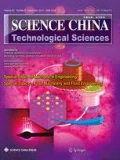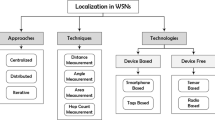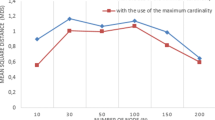Abstract
Node positioning is a fundamental problem in applications of wireless sensor networks (WSNs). In this paper, a new range-free algorithm, called spring swarm localization algorithm (SSLA), is proposed for positioning WSNs. To determine the locations of sensor nodes, the proposed algorithm uses network topology information and a small fraction of sensor nodes which know their locations. Numerical simulations show that high positioning accuracy can be obtained by using the algorithm. Some examples are given to illustrate the effectiveness of the algorithm.
Similar content being viewed by others
References
Capkun S, Hamdi M, Hubaux J P. GPS-Free positioning in mobile ad-hoc networks. Cluster Comput, 2002, 5(2): 157–167
Girod L, Estrin D. Robust range estimation using acoustic and multimodal sensing. Proceeding of the IEEE International Conference on Intelligent Robots and Systems, Maui, Hawaii, USA. 2001: 1312–1320
Priantha N B, Chakraborty A, Balakrishnan H. The cricket location-support system. Proceeding 6th ACM International Conference on Mobile Computing and Networking (ACM MOBICOM), Boston, MA. 2000: 32–43
Savvides A, Han C C, Srivastava M B. Dynamic finge grained localization in ad-hoc networks of sensors. Proceeding 7th Annual Int’1 Conf on Mobile computing and Networking (MoviCom), Rome, Italy. 2001: 166–179
Savvides A, Park H, Mani B, et al. The bits and flops of the N-hop multilateration primitive for node localization problems. Proceeding 1st ACM Int’1 Workshop on Wireless Sensor Networks and Application, Atlanta, GA. 2002: 112–121
Niculescu D, Nath B. Ad hoc positioning system (APS) using AOA. Proceeding 22nd Annual Joint Conference the IEEE Computer and Communications Societies (IEEE INFOCOM 2003). 2003: 1744–1753
Priyantha N B, Miu A K L, Balakrishnan H, et al. The cricket compass for context-aware mobile applications. Proceeding of the 7th Annual Int’l Conference on Mobile Computing and Networking. Rome: ACM Press, 2001. 1–14
Bahl P, Padmanabhan V N. RADAR: An in-building RF-based user location and tracking system. Proceeding of IEEE Infocom 2000, Tel Aviv, Israel. 2000: 775–784
Girod L, Bychovskiy V, Elson J, et al. Locating tiny sensors in time and space: A case study. Proceeding of the 2002 IEEE Int’l Conf. on Computer Design: VLSI in Computers and Processors. Freiburg: IEEE Computer Society, 2002. 214–219
Galstyan A, Krishnamachari B, Lerman K, et al. Distributed online localization in sensor networks using a moving target. Proceeding Third Internattional Symposium on Information Processing in Sensor Networks. New York: ACM Press, 2004. 61–70
Nagpal R, Shrobe H, Bachrach J. Organizing a global coordinate system from local information on an ad hoc sensor network. Proceeding in Sensor Networks: Second International Workshop, IPSN 2003, No. 2634. Lecture Notes in Computer Science. Palo Alto: Springer, 2003. 333–348
Meesookho C, Mitra U, Narayanan S. On energy-based acoustic source localization for sensor network. IEEE Trans Signal Process, 2008, 56(1): 365–377
Langendoen K, Reijers N. Distributed localization in wireless sensor networks: A quantitative comparison. Comput Netw, 2003, 43(4): 499–518
Sheng X H, Hu Y H. Maximum likelihood multiple-source localization using acoustic energy measurements with wireless sensor networks. IEEE Trans Signal Process, 2005, 53(1): 44–53
Bulusu N, Heidemann J, Estrin D. GPS-less low cost outdoor localization for very small devices. IEEE Pers Commun Mag, 2000, 7: 28–34
Doherty L. Algorithms for position and data recovery in wireless sensor networks. Masters Report, University of California, Berkeley, CA, 2000
Nicolescu D, Nath B. Ad-hoc positioning systems (APS). Proceeding of the 2001 IEEE Global Telecommunications Conference. San Antonio: IEEE Communications Society, 2001, 5. 2926–2931
Niculescu D, Nath B. DV based positioning in ad hoc networks. J Telecommun Syst, 2003, 22: 267–280
He T, Huang C, Blum B M, et al. Range-free localization schemes for large scale sensor networks. Proceeding 9th Annual International Conference on Mobile Computing and Networking, 2003. 81–95
Shang Y, Ruml W, Zhang Y, et al. Localization from mere connectivity. Proceeding of the Fourth ACM Internat. Symposium on Mobile ad hoc Networking and Computing MOBIHOC 2003. NewYork: ACM Press, 2003. 201–212
Lim H, Hou J. Distributed localization for anisotropic sensor networks. ACM Trans Sensor Netw, 2009, 5(2): 1–26
Doherty L, Pister K S J, Ghaoui L E. Convex position estimation in wireless sensor networks. Proceeding of the IEEE INFOCOM 2001. Anchorage: IEEE Computer and Communications Societies, 2001, 3. 1655–1663
Stupp G, Sidi M. The expected uncertainty of range-free localization protocols in sensor networks. Theor Comput Sci, 2005, 344(1): 86–99
Eren T, Goldenberg D, Whiteley W, et al. Rigidity and randomness in network localization. IEEE Infocom, 2006, 4: 2673–2684
Anderson B D O, Belhumeur P N, Eren T, et al. Graphical properties of easily localizable sensor networks. Wirel Netw, 2009, 15(2): 177–191
Aspnes J, Eren T, Goldenberg D K, et al. A theory of network localization. IEEE Trans Mobile Comput, 2006, 5(12): 1663–1678
Vincent T, Cheng K Y, Lui K S. Using micro-genetic algorithms to improve localization in wireless sensor networks. J Commun, 2006, 1(4): 1–10
Nan G F, Li M Q, Li J. Estimation of node localization with a real-coded genetic algorithm in WSNs. Proceeding the Sixth International Conference on Machine Learning and Cybernetics, Hong Kong, 19–22, August, 2007. 2007: 873–878
Yun S, Lee J, Chung W, et al. A soft computing approach to localization in wireless sensor networks. Expert Syst Appl, 2009, 36(4): 7552–7561
Chuang P J, Wu C P. An effective PSO-based node localization scheme for wireless sensor networks. Proceeding 2008 Ninth International Conference on Parallel and Distributed Computing, Applications and Technologies. 2008: 187–194
Author information
Authors and Affiliations
Corresponding author
Rights and permissions
About this article
Cite this article
He, Q., Chen, F., Cai, S. et al. An efficient range-free localization algorithm for wireless sensor networks. Sci. China Technol. Sci. 54, 1053–1060 (2011). https://doi.org/10.1007/s11431-011-4351-y
Received:
Accepted:
Published:
Issue Date:
DOI: https://doi.org/10.1007/s11431-011-4351-y




